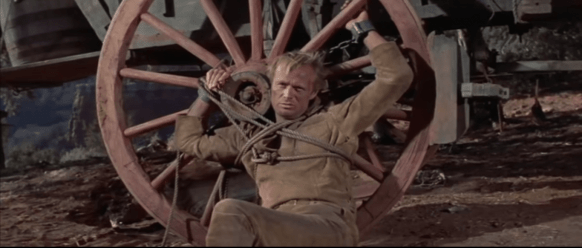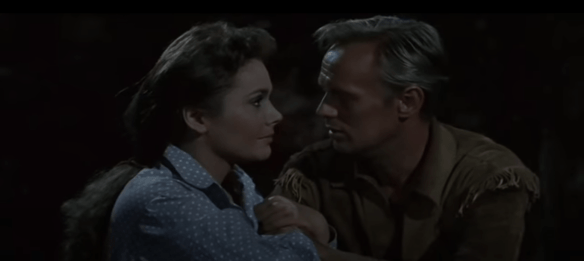
We’re in the Arizona territories. The year is 1873. Glorious overhead shots give us a sense of the vast panorama of the terrain in CinemaScope as Richard Widmark gets hunted down and returns the fire of his pursuers.
The distinctive red rocks have the hint of John Ford and if nothing else, remain a stunning reminder of America’s glorious topography. We really live in a gorgeous place if we take the time to get out in it.
For Widmark, it’s life or death as he kills one assailant only to get winged and dragged behind a horse by the wrists. It’s hardly water skiing. This is the untidy, rough-and-tumble law of the wide-open land. The victors are those who survive, whether through chicanery, brute strength, or guns loaded with lead.
It feels like we’ve been privy to a whole short movie before our main storyline has even begun. This is to The Last Wagon’s credit. It has robust beginnings and makes Widmark out to be an intriguing enigma right from the outset.
We find him finally, dead beat, strung up in a tree for safekeeping in the custody of a sadistic sheriff (George Matthews) as a wagon train of women and children scuttle by. They couldn’t be more diametrically opposed, but this is the entire premise of the movie right here.
It’s their leader (Douglas Kennedy) who welcomes the lawman into their company, wary of both prisoner and his executioner. It’s an uneasy partnership to be sure. He makes his moral stance quite clear when he blesses their evening meal, “Teach us to live with open hearts and share with our fellow man our values.” It falls on the deaf ears of Bull Harper and “Comanche” Todd, who is trussed up to a nearby wagon wheel.
The wanted criminal doesn’t help his case when he murderers yet another man in view of a whole wagon train of incredulous witnesses. They aren’t accustomed to such savagery. He comes back sharply, “I had a right to kill him, but I suppose my side of the story doesn’t interest you none.” It plays as another pointed comment on who he is: both a murderer and a “white” Comanche, and then who they are, naive Christian pilgrims.
There are two individuals in their ilk, in particular, who show him a dose of Christian compassion. The young boy Billy (Tommy Rettig) brings him food, with all the candor in the world, asking him honestly if he thinks he’ll go to heaven. It’s hardly out of a place of browbeating or scorn, but genuine concern. He’d like to go scouting with Todd up in Heaven because Billy aims to be there. He wants the other man to be there too. His older sister Jenny (Felicia Farr in an amiable and lucid performance) also extends him a certain benefit of the doubt.
Unfortunately, the movie’s attempt at commentary on prejudice is partially undermined in all its good intention. It begins with Widmark. Although it’s partially explained away through exposition, he’s certainly no Indian by birth. Likewise, in a precursor to her mixed-race role in Imitation for Life, Susan Kohner is given the role of a half-Navajo girl, who faces bigotry with a stolid resolve. It is her bratty half-sister (Stephanie Griffin), white by birth, who encapsulates all the malicious prejudices festering on the range. This is made plainly evident.
However, Delmer Daves does not constrict his movie into being a mere morality play. In fact, The Last Wagon is hard to pin down. There are all these potential narrative offshoots, and it supplies some genuine moments of surprise while still mixing its messages and becoming an entirely different narrative on multiple occasions. One prime example is how the movie is both indicting prejudices against American Indians and still somehow using them as a mechanistic trope of the West.
Gratefully, the movie splits off from the pack and hones in on the most intriguing characters. One drastic turning point comes when all the adolescents sneak off to go skinny-dipping, including the scandalized Valinda and the foxy Ridge (Nick Adams). They’re the story’s resident imbeciles. For the time they can frolic gaily only for the rapids to give them a scare, and then worse…

They return to nothing — a camp totally decimated — Widmark is the only one left, cast aside on his wagon wheel. Valinda chastises him, “You got no right to be alive when our people are dead!” Here we find the meat of our story. It settles into being a survival western with Richard Widmark anchoring the youthful contingent following his lead. Their objective is obvious, making their way through the aptly bone-chilling “Canyon of Death.” They have no other alternative. Widmark is the only one who knows what it takes to survive.
The Last Wagon has some downright bizarre moments — setting traps for food and Widmark makes it look like a breeze ambushing their dinner in a cave. In a matter of minutes, snake bites, apache ambushes, and they just keep on coming; it’s the kind of western melodrama not averse to tossing out all sorts of wrinkles, and why not? There’s a lot to work with. Either you laugh it off as absurd or you admire the commitment to making the story lively. The same goes for the dialogue. It’s not the most nuanced job, but it keeps the pulse going.
There are obligatory interludes too as he hacks off his handcuffs across from Farr while sharing his life story. We get something of his own spiritual belief system. His father was a circuit-riding preacher — he was even baptized — and his daddy looked to carry the word of his God to the whole world, that is until he died. The operative word is “his” God because Todd was adopted by a Comanche chief and never looked back. If this God wasn’t concerned with saving his father, then he wasn’t interested.
Still, they just might receive a providential intervention yet in the form of some horse soldiers. However, their saviors in Calvary uniforms turn out to be a reconnaissance unit, and with Indians on the warpath fast approaching, it becomes Todd’s time to rescue all of them. He knows the dilemma: Get them out of their hopeless predicament only to find himself on trial for murder.
It becomes a layman’s civil discourse. Law is law — Comanche or white — if it is just. The question remains who gets to decide Justice? Jenny comes to her man’s defense: The Good Book says something about taking life but what about giving life back? This is what he’s done for them — provided a lifeline in a hopeless scenario. Needless to say, whatever the parameters most human systems are flawed and infallible. They don’t always hold up.
In the end, there’s a kind of swelling sentiment as we watch redemption at work. The young men and women sitting before the courts as a testament to Todd’s decency. After such a treacherous journey, it’s convenient and painless. So be it. It feels equally grand to watch Widmark ride off with Farr and Rettig. It hits all the beats like a western such as this is supposed to. Nothing more is required.
Delmer Daves puts together an oater with a gorgeous sense of the Western vistas in its many earthy hues. Any ways in which it feels heavy-handed or derivative are mostly smoothed over by a typically stalwart performance by Widmark (and the fact I’m fond of Farr and Rettig). The Last Wagon is a pleasant surprise, and it need not be more.
3.5/5 Stars
